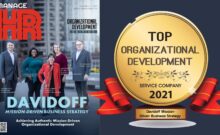They were stuck.
Some time ago, the Chicago chapter of an international membership organization approached us for help.
The organization had a strong reputation in its sector, but things had been slipping: attendance at monthly programs was down, as was membership retention. Newer, more innovative competitors were having much greater success.
Leadership recognized the need for change. Not only did they see the suboptimal numbers, but they weren’t attracting new board members to step up to the plate. The board chair recognized they needed a new vision for the organization, and a new strategic plan to lead the organization forward.
This article is about what happens when a systems orientation is brought into traditional operations-oriented strategic planning. In our 15 years of observing and supporting organizations to identify where they are Mission-Driven and where they are Mission-Challenged, we have seen the power of a systems point of view in helping organizations identify the need for change and chart a transformational for the future.
The core challenge is that organizations, from local homeless shelters to national philanthropic foundations to government agencies and associations, are systems. And the first law of systems theory is that a system will strive for homeostasis — in simple terms, it will try to maintain itself as it currently is, even if that’s not for the best.
We recommend the following steps to apply a systems approach to your organization. We have illustrated each step using the process we led the membership organization through so you can follow along.
Step 1: Disrupt the System
For this organization, the board needed outside perspective to realize it was a system that was stuck in “operate” mode. We began by thoroughly assessing individual departments: products, programs and services, sales, operations, marketing, membership, and others. Many mission-challenged organizations become internally focused — as systems are designed to do. As a result, they lose track of important shifts in their external environment. This can lead to a loss of relevance to customers, members, donors, volunteers, and strategic partners.
Such an assessment is disruptive in a healthy way, as it gets people thinking about things that could be improved, even if there’s not yet a plan in place to change anything.
Step 2: Look Outside the Organization for Feedback
Along with an assessment of internal departments, it’s important to seek external perspectives on the organization.
- What do members need?
- Where are programs relevant?
- Where are they not?
- What are competitors offering that are more attractive?
- What do key leaders in the sector think about the organization and its relevance?
- What are the gaps the organization could fill to help members be more effective in their own missions?
We conducted interviews with active members, former members, and industry leaders, and generated and presented answers to those questions to the organization. Leaders seemed to “get” it. Specifically, the board, an all-volunteer group of professionals who were truly invested in and committed to the organization, understood things had to change:
“Business as usual” wasn’t working any more. They had lost relevance to their members. The market had changed, but they had not changed with the market.
Calling leadership forward in this way had a strongly positive effect, like a collective exhale. We had reached a shared understanding built on systems thinking: the system was resistant to change, which manifest itself as anxiety and passiveness among leaders.
Step 3: Create a Powerful Vision that’s Compelling and Relevant
Leadership made an active choice to move toward a powerful new vision they articulated, while recognizing the challenges ahead. They identified five key strategic priorities and met as working groups to identify goals, outcomes and clear milestone dates, years 1, 2 and 3. Over time, they executed on the strategic plan. Board members reported on progress towards strategic plan goals at every board meeting, making changes as they went. They were ultimately able to hit the board’s diversity goal of 50% of new members. They turned around their membership losses and saw a solid and consistent uptick in monthly program attendance. “You made sure we really bought into the work,” one board member said.
Below, we share several tips for Mission-Drivers who want to lead needed change in their organizations:
- Take a systems view: Understand that you’re part of a system including your culture, your operations, and every aspect of your organization. Even the way meetings get run.
- Assess each element. Identify what aspects of your organization support your mission, and which are kept “because we’ve always done it this way.” If it’s not working, collectively discuss what change is needed and map out the new pathway.
- Recognize the need to create change. Move toward it, rather than away. Get that being comfortable in your system is actually a sign of being on “idle” and eventually, decline.
- Paint the picture: Step outside your system (or get outside help) to get the full picture of organizational status and gaps to fill. Do research, ask tough questions, seek full answers, understand their implications.
- Craft the vision: Use a strategic planning process to develop a comprehensive new vision for the organization that is collaborative and from the ground up, rather than top down.
- Assign ownership: Is someone accountable for each element of the plan? Develop clear, measurable outcomes to track progress toward well-defined milestones. The buck must stop somewhere.
- Embrace the anxiety: Recognize that you will — and should — feel anxiety about leaving the familiar. That means you see what is possible and you’re in the game!
Any organizational journey must start with an understanding of the system and a willingness to admit to problems or gaps between vision and reality. Think about how your organization can embrace greater systems thinking to promote self-awareness, accountability to the mission, and even its own growth and transformation.




